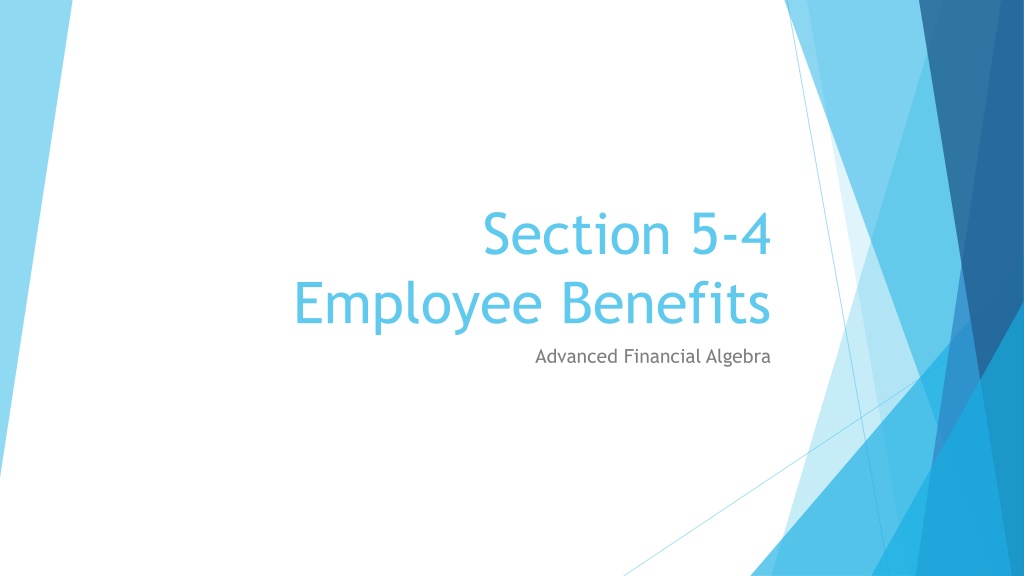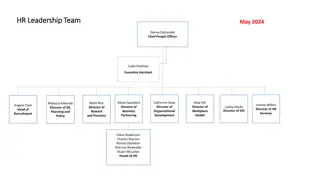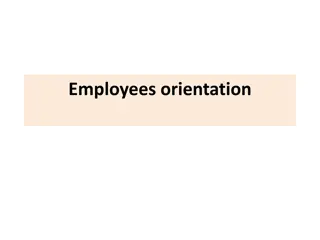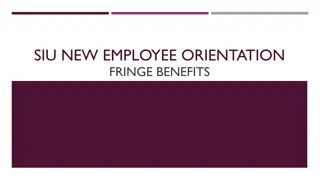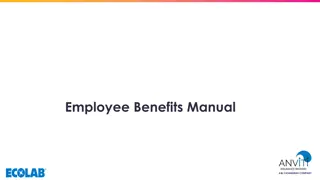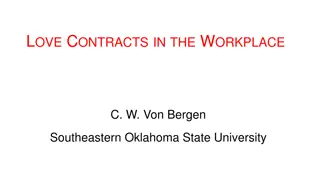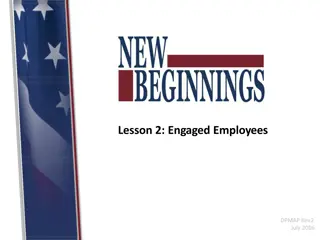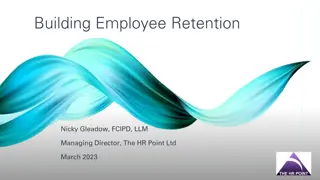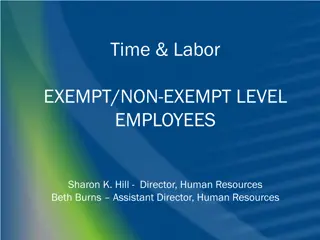Understanding Employee Benefits in the Workplace
Employee benefits play a crucial role in job satisfaction and employee well-being. Required benefits such as unemployment insurance and worker's compensation help protect employees in difficult situations. Other benefits like paid vacation time, health insurance, retirement plans, and more, can vary by job and company, enhancing the overall work experience. Through examples, such as calculating paid vacation days and employer contributions for health care, this content provides valuable insights into understanding and maximizing employee benefits.
Download Presentation

Please find below an Image/Link to download the presentation.
The content on the website is provided AS IS for your information and personal use only. It may not be sold, licensed, or shared on other websites without obtaining consent from the author. Download presentation by click this link. If you encounter any issues during the download, it is possible that the publisher has removed the file from their server.
E N D
Presentation Transcript
Section 5-4 Employee Benefits Advanced Financial Algebra
What are the benefits of a job? Required Benefits Unemployment insurance offers temporary assistance to people who are out of a job through no fault of their own Worker s compensation offers assistance to employees who are injured while working at their job Paid sick leave - Any employee who works in California for 30 days or more is entitled to receive paid sick leave. An employer is required to provide a minimum of 3 days, or 24 hours, of sick leave per year, and an employee may begin to take sick leave after 90 days of employment. Paid sick leave may accrue at a rate of 1 hour for every 30 hours worked, and must be reflected on each wage statement.
Other possible benefits (not required) - vary by job and company Insurance (health insurance, life insurance, and disability insurance) Check for family health care vs. individual only health care Paid vacation time Paid time off (PTO) often holiday pay Paid sick leave Retirement plans 401k Pension etc Stock ownership plans Childcare leave and more
Example 1 paid vacation time Alan works for a printing company and is now making $54,080 per year. It has been a little over 4 years since he was hired. When he was hired, he was told that he had 5 days of paid vacation time. For each year that he worked at the company, he would gain another 2 days of paid vacation time to a maximum of 20 days. How many paid vacation days does he now get at the end of 4 years of employment and how much money will he earn while he is on vacation? SOLUTION: His weekly salary = $54,080/52 weeks = $1,040 per week Since he has already worked for 4 years, he gets the 5 days of vacation he started with +2+2+2+2 for the 4 years he worked = 5+2+2+2+2 = 13 days of paid vacation. # paid work weeks = 13/5 days he works per week = 2.6 weeks of paid vacation $1,040 per week * 2.6 weeks = $2,704 paid vacation
Example 2 employer contribution for health care Frieda s employer offers her family health care as an employee benefit. She must contribute 12% of the cost, and her employer will cover the rest. Frieda gets paid biweekly, and $88.50 is taken out of each paycheck for her portion of the family health care coverage. How much does Frieda s employer contribute for her coverage? SOLUTION: Frida s contribution (payment) = $88.50 per check * 26 paycheck in a year since she is paid every other week = $2,301 per year that she pays total from her check She only paid 12% = .12 as a decimal 12% of the total = $2,301 (the amount she paid) .12x = 2301 algebraic equation x = $19,175 = total cost of her health care divide both sides by .12 Employer s contribution = total her part = $19,175 - $2,301 = $16,874
Example 3 pension Marina is the director of the Washington Performing Arts Center. Her employer offers a pension and Marina is planning on retiring at the end of this year after 25 years of employment. She will receive 1.5% of his or her average salary for the last 5 years of employment multiplied by the number of years worked. Marina would receive this amount each year until her death. Her salaries for the last 5 years are $88,900; $92,200; $96,000; $98,000; and $102,000. SOLUTION: # ?? ?????= 88,900+92,200+96,000+98,000+102,000 ????? Marina s 5-year average salary = = $95,420 5 Pension = 1.5% of that average * # years worked = (.015) * $95,420 * 25 years = $35,782.50 Marina will receive a pension of $35,782.50 per year until her death.
Example 4 unemployment In Reese s state, the weekly unemployment compensation is 60% of the 26-week average for the two highest-salaried quarters. A quarter is 3 consecutive months. For July, August, and September, he earned a total of $9,024. In October, November, and December, he earned a total of $9,800. Determine Reese s unemployment compensation. SOLUTION: 26 weeks = half of a year = 6 months (July, August, September, October, November, December) Total pay for those six months = $9,024 + $9,800 = $18,824 # ?? ???? ?= $18,824 ????? 26-week average = = $724 Reese earned on average per week 26 He gets 60% of that average = (.60) * $724 = $434.40 per week
Assignment: Pg 318 # 4, 6, 8, 9 4. When Luis started his job, his employer told him that he would receive 2 vacation days for each full year he worked. Let x represent the number of years he has worked for the company and y represents the number of paid vacation days he earned. a. Write an equation that models the relationship between these two variables, x and y. b. How long will it take him to earn 18 paid vacation days? Set the equation from a. equal to 18 and solve it. 6. 8. 9.
